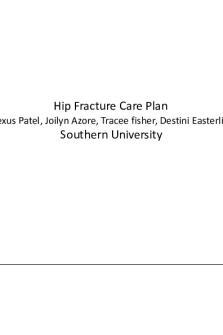Hip special tests PDF

| Title | Hip special tests |
|---|---|
| Author | Rachel Allan |
| Course | Sports Therapy |
| Institution | City of Glasgow College |
| Pages | 4 |
| File Size | 252.1 KB |
| File Type | |
| Total Downloads | 93 |
| Total Views | 131 |
Summary
Hip special tests...
Description
Assessment of the Hip
Trendelenburg Test: A test for weakness of the gluteus …………………………..muscle during unilateral weight bearing. Therapist is positioned behind patient to observe the pelvis. The patient assumes a unilateral stance on the test side extremity. A positive sign is indicated by the pelvis dropping toward the unsupported limb
Obers’ test: Ober Test: a test to determine if a patient has tightness of the………………………………………………………. ……………………..and or ………………………………………………………………………………………………..The subject is positioned sidelying with the test limb on top. The hip and knee of the limb closest to the plinth should both be flexed to stabilize the patient. The ……………………………….. limb is passively positioned into abduction and extension so the ITB passes over the greater trochanter. The knee may be either flexed or extended, but a greater stretch will be felt in extension. The examiner stabilizes the pelvis to prevent substitution and then allows the test limb to slowly adduct towards the table. A positive test is indicated by …………………………………………………………………………………table.
Above two variations of ober’s test
Thomas Test: a test to determine if a patient has tightness of the………………………………………………………………….……… and or ………………………………………………………………………... The patient is positioned ……………………….on the plinthe. The subject is then asked to bring both knees to their chest and to hold the untested limb with their hands. The examiner then passively lowers the test limb to the plinth. If the limb remains up off the table,…………………………………………….. ……………………..a hip ……………………………………………is suspected. To differentiate muscles, the examiner then passively extends the …………………………………..placing the ……………………………………………………….on slack. If the test limb lowers to the table the …………………………………………………………..is shortened. If the test limb remains off the table with the knee flexed the ……………………………………………………………………….is shortened.
Scouring (Quadrant) Test: a test for non-specific joint pathology. The examiner takes the test extremity and passively brings it into flexion. While applying ……………………………….load the examiner then moves the extremity in all quadrants. A positive test is indicated by clicking, crepitus or pain.
SI joint Test: With the patient standing, palpate PSIS with thumb on both sides. With normal SI mobility the PSIS should rotate ………………………………………..on the leg that is raised off the floor.
Capsule :- Patient lies in …………………………………… position. Knee is bent to slightly less than 90 and hip is put into slight adduction. Examiners hand is placed under patients’ ………………………..and leg is lifted.
Iliofemoral: - Patient lies in ………………………….position. Hip is put into slight abduction. Examiners hand is placed under patients’ thigh and leg is lifted.
Ischiofemoral: - Patient lies in supine position. Knee and hip are bent to 900. Examiner angles patients knee towards midline and moves knee towards patient’s chest.
Pubofemoral: - Patient lies in supine position. Knee and hip are bent to 90. Examiner moves knee towards patient’s chest in line with the …………………………………………… ....
Similar Free PDFs

Hip special tests
- 4 Pages

Tests -
- 2 Pages

Tests
- 3 Pages

makalah musik hip hop.docx
- 8 Pages

makalah musik hip hop.docx
- 8 Pages

Hip -Hop essay assignment
- 2 Pages

Hip Hop Midterm Notes
- 11 Pages

Hip Hop Final Notes
- 8 Pages

Special Inclusions
- 4 Pages

Special Transactions
- 15 Pages

Hip Fracture Care Plan
- 5 Pages

EJE HIP- Adeno- Ovario
- 2 Pages

Concept Map Hip Fracture
- 2 Pages
Popular Institutions
- Tinajero National High School - Annex
- Politeknik Caltex Riau
- Yokohama City University
- SGT University
- University of Al-Qadisiyah
- Divine Word College of Vigan
- Techniek College Rotterdam
- Universidade de Santiago
- Universiti Teknologi MARA Cawangan Johor Kampus Pasir Gudang
- Poltekkes Kemenkes Yogyakarta
- Baguio City National High School
- Colegio san marcos
- preparatoria uno
- Centro de Bachillerato Tecnológico Industrial y de Servicios No. 107
- Dalian Maritime University
- Quang Trung Secondary School
- Colegio Tecnológico en Informática
- Corporación Regional de Educación Superior
- Grupo CEDVA
- Dar Al Uloom University
- Centro de Estudios Preuniversitarios de la Universidad Nacional de Ingeniería
- 上智大学
- Aakash International School, Nuna Majara
- San Felipe Neri Catholic School
- Kang Chiao International School - New Taipei City
- Misamis Occidental National High School
- Institución Educativa Escuela Normal Juan Ladrilleros
- Kolehiyo ng Pantukan
- Batanes State College
- Instituto Continental
- Sekolah Menengah Kejuruan Kesehatan Kaltara (Tarakan)
- Colegio de La Inmaculada Concepcion - Cebu


